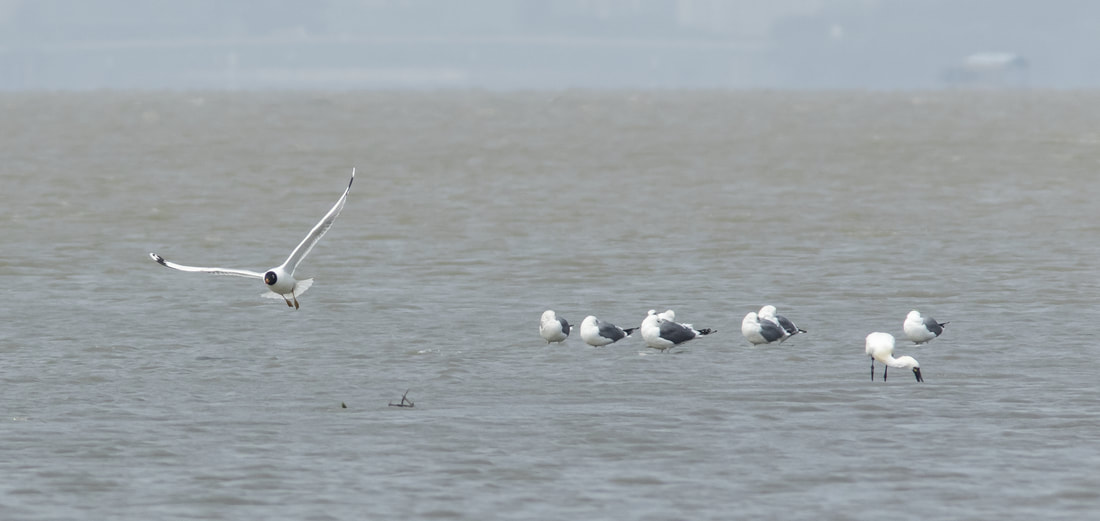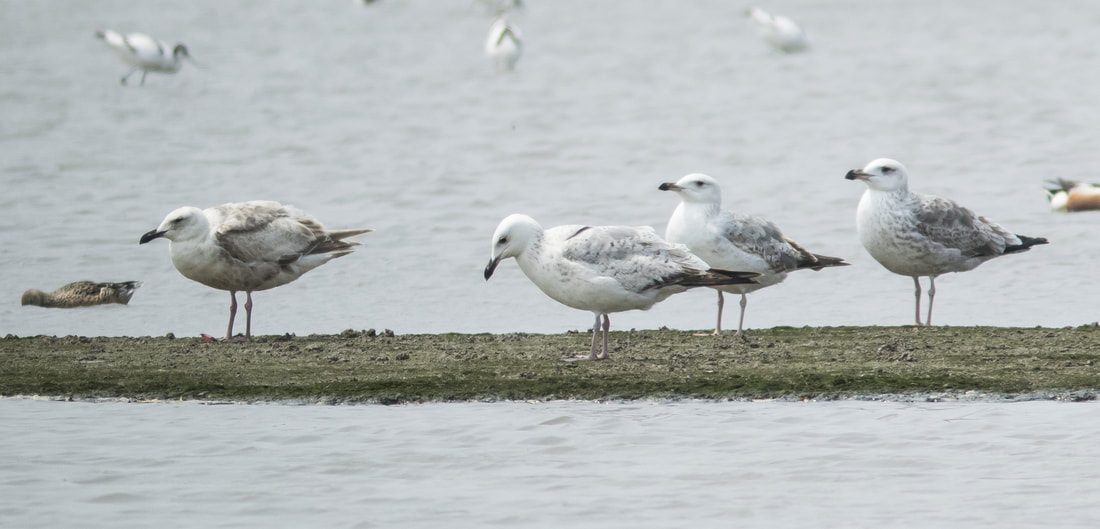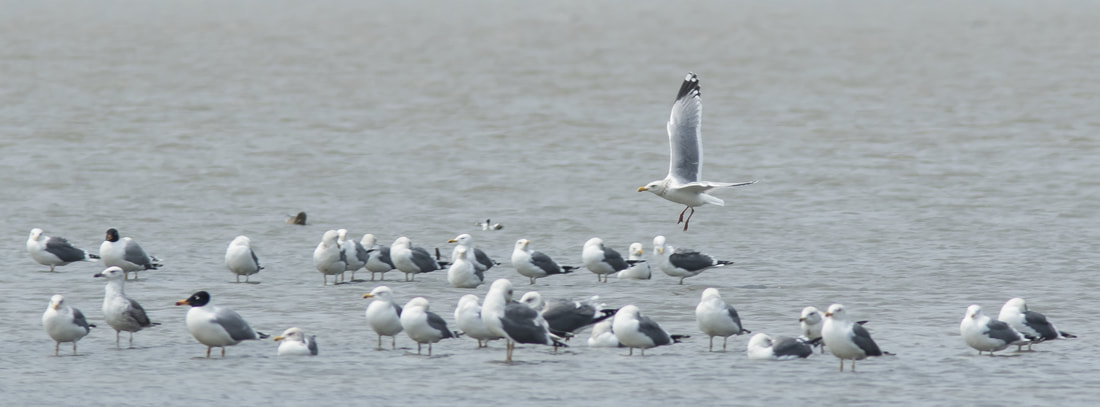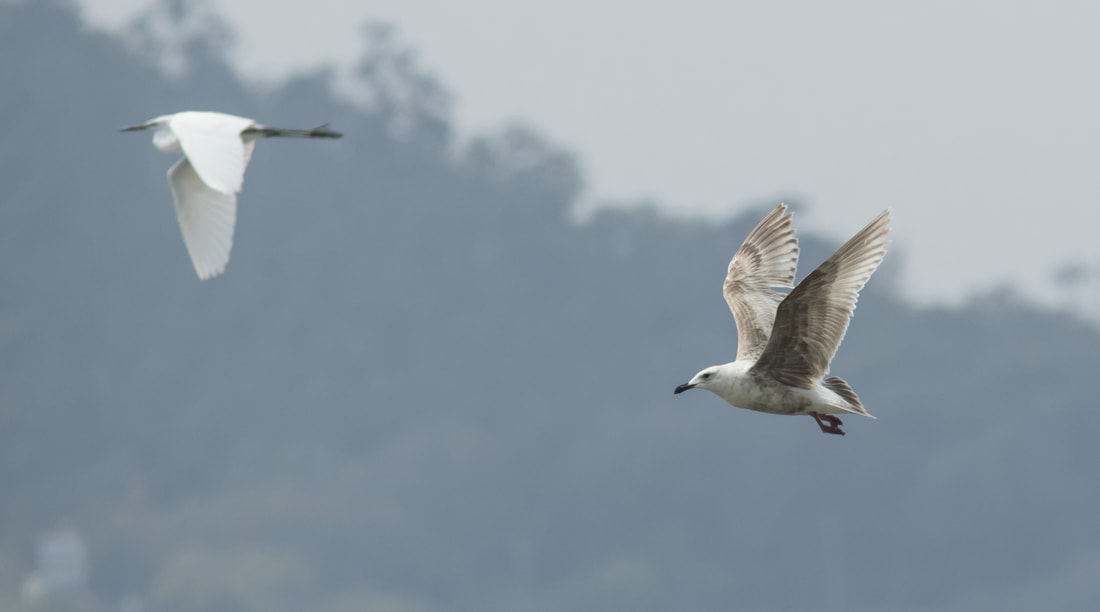|
I went bird watching from the northern hide at Mai Po boardwalk on March 17th. A gently rising morning tide gradually brought birds closer to the hide, amongst them the larger gulls. (The Black-headed and Saunders’s Gulls tend to congregate in the centre of the mud flats, closer to the southern hide.) I counted 97 Heuglin’s Gulls, at least four Caspian (mongolicus) Gulls, two Pallas’s Gulls, a Vega Gull, and a Slaty-backed Gull (as well as a Black-tailed Gull – not discussed below) and managed to get a few (much-cropped) record shots of some of these birds. The Pallas’s Gulls were adults in breeding plumage, making identification easy. This species is a scarce but almost annual winter visitor & spring passage migrant to Deep Bay. It has been recorded between 21st November and 7th April. The highest number to occur together was five on 8th March 2017. It breeds from Central Asia west to the Ukraine and east to west Mongolia, and winters from the Middle East to India and Bangladesh, being scarce further east to Thailand & Hong Kong. The other large gulls can be more difficult to identify, especially in non-adult plumages, and their taxonomic status is often contentious; different authorities have different ideas on how certain species should be classified. Most authorities tend to agree that Heuglin’s Gull is a race of Lesser Black-backed Gull, hence its scientific name Larus fuscus heuglini. This is accepted by the International Ornithological Congress (IOC), by the Handbook of the Birds of the World (HBW) and by J. F. Clements (whose taxonomy is used by the Cornell Lab of Ornithology and therefore by ebird). As the count above indicates, it is the commonest large gull in Hong Kong. It occurs as a winter visitor to Deep Bay and a spring passage migrant through offshore waters. It has been recorded between 6th September and 30th April, with one summer record – a 1st-year bird over-summered in Deep Bay in 2014. The highest count on record is 865 on 28 Jan 2000. In his recent book Gulls of the World (2018), Klaus Malling Olsen treats heuglini as a separate species with two races: L. h. heuglini and L. h. taimyrensis. These two forms have distinct breeding and wintering areas. L. h. heuglini breeds in north Russia between the Kola and Yamal peninsulas; it winters south to the Red Sea, the Arabian Gulf and the north Indian Ocean, southwest to the east African coastline and southeast to Sri Lanka. L. h. taimyrensis breeds between south west Taimyr and the Kara Sea; it winters in coastal east Asia north to Japan and south to Hong Kong. L. h. taimyrensis was traditionally considered a hybrid population between heuglini and Vega Gull. However, according to Olsen, "recent genetic analysis proves that it represents a distinct population." Unfortunately, perhaps, taimyrensis seems to have disappeared from the other taxonomies referred to above. The other regular large gull to occur in Deep Bay is what birders here generally refer to as “mongolicus.” The taxon breeds from southeast Altai and Lake Baikal to Mongolia, northeast China and Korea; it winters in Japan, Korea, and eastern and southern China. It has been recorded in Deep Bay between 28th November and 17th April (although one over-summered in 2017). The highest count on record is 25 on 13th March 2000. The HKBWS Records Committee (RC) generally follow IOC taxonomy, which regards mongolicus as a race of Vega Gull, hence Larus vegae mongolicus. However, on this occasion, the RC differs from the IOC and treats mongolicus as a subspecies of Caspian Gull, Larus cachinnans mongolicus. This was the position of Olsen & Larsson in their book Gulls of Europe, Asia and North America (2004). However, in Gulls of the World (2018), Olsen states that “Mitrochondial DNA analysis shows Mongolian Gull to be genetically close to Vega Gull”; Olsen, in fact, treats it as a species in its own right although hedges his bets by titling the section “Mongolian Gull Larus (vegae) mongolicus”. (To make matters even more complicated, HBW treats both mongolicus and vegae as races of Arctic Herring Gull Larus smithsonianus, and Clements treats it - and vegae - under Herring Gull Larus argentatus!!) Note, however, that none of these authorities currently link mongolicus to cachinnans. As the last paragraph shows, the taxonomic position of Vega Gull is also problematic. However, the IOC treats it as a distinct species, a viewpoint followed by both the RC and Olsen. In Hong Kong, it is a scarce winter visitor in very small numbers to Deep Bay, extreme dates of occurrence being 31st December and 6th April. The highest count was five on 29th January 2012. It breeds in northeast Siberia and winters south to Japan, Korea and southeast China. Slaty-backed Gull breeds in coastal northeast & east Siberia, and northern Japan; it winters from the Bering Sea to the Sea of Japan, and in small numbers south to the coasts of south China and Taiwan. It is a scarce but annual winter visitor and spring passage migrant to Deep Bay, and has been recorded between 26th November and 3rd April. The highest count was seven on 25th January 2000.
0 Comments
|





 RSS Feed
RSS Feed
